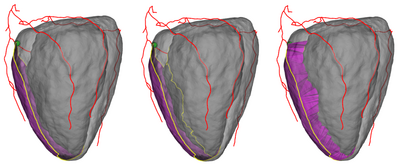Difference between revisions of "Projects:RiskMassEstimation"
From NAMIC Wiki
| Line 3: | Line 3: | ||
= Description = | = Description = | ||
| − | The proposed method has three major components: First, extract the coronary arteries from CTA image and identify stenoses with severe occlusions. Second, segment the left ventricular surfaces from CTA image. Third, estimate the affected mass based on the segmentations of the arteries and left ventricle. | + | The proposed method has three major components: First, extract the coronary arteries from CTA image and identify stenoses with severe occlusions. Second, segment the left ventricular surfaces from CTA image. Third, estimate the affected mass based on the segmentations of the arteries and left ventricle. These steps are illustrated in the figure below. |
| + | |||
| + | *[[File:RiskMassSteps.png|400px]] | ||
| + | Volume at risk estimation process. Left: Extract the area at risk (purple) on the epicardial surface given the stenosis location (greed dot) on the coronary arteries (red lines). Middle: Trace out the risk contour (yellow) on the endocardial surface. Right: Construct the volume at risk (purple). | ||
= Results = | = Results = | ||
Revision as of 02:31, 20 November 2012
Home < Projects:RiskMassEstimationBack to Boston University Algorithms
Description
The proposed method has three major components: First, extract the coronary arteries from CTA image and identify stenoses with severe occlusions. Second, segment the left ventricular surfaces from CTA image. Third, estimate the affected mass based on the segmentations of the arteries and left ventricle. These steps are illustrated in the figure below.
Volume at risk estimation process. Left: Extract the area at risk (purple) on the epicardial surface given the stenosis location (greed dot) on the coronary arteries (red lines). Middle: Trace out the risk contour (yellow) on the endocardial surface. Right: Construct the volume at risk (purple).
